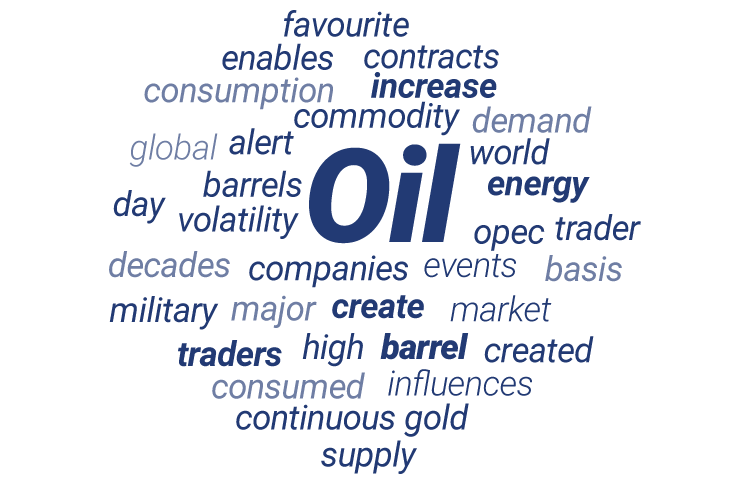CL Price: What Influences the Price of Oil?
Date Modified: 2025/07/20
From extraction to consumption, oil is the basis for many common products, offering traders ample opportunities to speculate on the commodity and the companies that rely on it.
Crude oil (CL), which is priced per barrel, can be used in various ways. It powers our homes as heating oil, enables transportation as gasoline, and even is the base of the plastics that house key components in our favourite gadgets. So it's no surprise that traders recognise both the short-term and long-term value of trading on this 'liquid gold' as our world becomes ever more dependent on the products it enables.
In this article, we dive into the factors that affect this key commodity to help traders and investors navigate trading it with more confidence:

TL;DR
- Oil is essential to energy, transport, and manufacturing.
- Highly volatile due to global events, supply-demand shifts, and trader sentiment.
- OPEC controls output to manage global prices.
- Geopolitical tensions (e.g., in the Middle East) can spike prices fast.
- Trader behaviour in futures markets influences short-term price swings.
- High risk, high reward, which makes it ideal for informed and agile traders.
Influences on Oil's Price
Supply & Demand
Oil is a consumable product, unlike gold (XAU) or other precious metals. Its usefulness is expended with each use, meaning that once it is consumed, more oil must be used to replace it. Oil is used in plastics ranging from thin films to military-grade parts and as a combustible fuel for locomotives, cars, buses, aeroplanes, and more.
Its seemingly endless uses in our modern world have created very high demand around the globe for this finite commodity.
Energy companies are racing to provide a continuous supply of 'liquid gold' by extracting 95.2 million barrels of oil per day around the globe in 2019. These include crude oil, shale oil, oil sand, and natural gas oils. Since the widespread implementation of fracking in 2006, the US has become a rising energy producer, reaching 12.2 million barrels of oil per day in 2019.
Although decades-long trends show an increase in oil consumption, various factors may reduce demand, having major consequences for traders, such as the September 11 attacks in 2001 and the Coronavirus pandemic in 2020. These major events led to a significant decline in air travel, grounding flights and leaving fuel unused. This created an unexpectedly high volume of supply, sowing uncertainty into the oil markets.
Geopolitical Events
While the cost of producing and shipping oil may remain relatively stable, geopolitical events have the potential to create volatility in the oil market. As manufacturers and traders rush to lock in rates, prices may fluctuate, rising and falling with global events.
An example of this can be a military conflict in the Middle East, where most of the world's oil is extracted, or a shift in political alliances that threatens to reduce the flow of this vital commodity. The conflict in the Middle East, particularly between Israel and Iran, has triggered heightened volatility in global oil markets, especially in June 2025. As tensions rose, oil prices experienced a sharp surge, with both Brent crude and West Texas Intermediate climbing more than 4% in a single day. This spike reflected growing concerns over potential disruptions to regional supply chains. Iran, the third-largest oil producer within OPEC, holds a critical position in the global energy landscape. Any threat to its production capabilities or to key shipping routes, especially the Strait of Hormuz, which handles around 20% of the world's seaborne oil, immediately raises alarms over the security of global oil supplies.
OPEC Decisions
The Organisation of Petroleum Exporting Countries (OPEC) is made up of Algeria, Angola, Congo, Equatorial Guinea, Gabon, Iran, Iraq, Kuwait, Libya, Nigeria, Saudi Arabia, the United Arab Emirates, & Venezuela. Founded in 1960, OPEC reports oil production per member country and collectively manages the amount of oil being produced. This ensures that their supply does not outpace demand.
Russia and the United States are not included in this group. They have become major energy producers over the last few decades and compete with OPEC for market share.

Trading sentiment
Trader sentiment can shift the price of oil by influencing the availability of traded futures.
If there is a major increase in traders purchasing Oil Futures contracts, it may alert other traders to a sudden price movement, triggering a further increase in trader volume and raising the commodity's price. On the other hand, if there is a lack of buyers in the market, or one of the above influences causes the market to believe that their contracts may become devalued, it may lower the value of an oil contract.
Oil as a Volatile Commodity
Oil, as discussed above, is vulnerable to market fluctuations and trader sentiments. This volatility keeps it a continuous favourite among traders but also brings its own risks.
A military flare-up, new OPEC output guidelines, or various other global events can send the price soaring or plummeting unexpectedly. This continuous movement can be profitable but comes with risks, meaning that traders should stay alert to market movements when opening buy or sell positions on this exciting commodity.
Conclusion
Oil remains a cornerstone of modern life, powering everything from vehicles to electronics. For traders, this creates both opportunity and risk.
Anyone engaging with this volatile commodity must understand the core factors, supply and demand, geopolitical events, OPEC's actions, and market sentiment. The complex, interconnected forces behind oil pricing mean that success in oil trading requires technical skill and a strong grasp of global affairs and long-term energy trends.
As the world continues to evolve, so too will the role of oil, and the opportunities for those willing to stay informed and adapt.
*Past performance does not reflect future results
FAQs
Oil prices are influenced by various factors, including geopolitical tensions, economic data, weather events, OPEC decisions, and trader sentiment, making it highly sensitive to sudden changes.
Conflicts or instability in major oil-producing regions (e.g., the Middle East) can disrupt supply or threaten shipping routes, causing immediate price spikes or drops.
The Organisation of the Petroleum Exporting Countries (OPEC) is a group of oil-producing nations coordinating production levels to stabilise oil prices. Their decisions significantly impact the global oil supply.
Since the rise of fracking, the U.S. has become a major oil producer, rivalling OPEC nations and influencing global supply levels.
Yes. If traders anticipate a rise or fall in oil prices, increased buying or selling of oil futures can amplify price movements, sometimes independent of physical supply and demand.
While renewables are growing, oil remains a crucial global commodity. Its continued use in transportation, manufacturing, and energy makes it a relevant and potentially profitable asset for traders, at least in the near to mid-term.
Learn More About Oil
Related News & Market Insights
Get more from Plus500
Expand your knowledge
Learn insights through informative videos, webinars, articles, and guides with our comprehensive Trading Academy.
Explore our +Insights
Discover what’s trending in and outside of Plus500.
Stay up-to-date
Never miss a beat with the latest News & Markets Insights on major market events.


